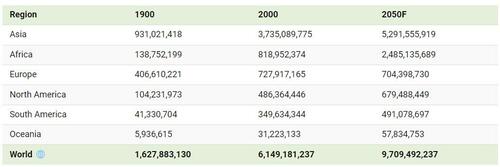Mapping Population Growth By Region (1900-2050F)
In fewer than 50 years, the world population has doubled in size, jumping from 4 to 8 billion.
In this visualization, Visual Capitalist’s Marcus Lu maps the populations of major regions at three different points in time: 1900, 2000, and 2050 (forecasted). Figures come from Our World in Data as of March 2023, using the United Nations medium-fertility scenario.
Population by Continent (1900-2050F)
Asia was the biggest driver of global population growth over the course of the 20th century. In fact, the continent’s population grew by 2.8 billion people from 1900 to 2000, compared to just 680 million from the second on our list, Africa.
China was the main source of Asia’s population expansion, though its population growth has slowed in recent years. That’s why in 2023, India surpassed China to become the world’s most populous country.
Southeast Asian countries like the Philippines and Indonesia have also been big drivers of Asia’s population boom to this point.
The Future: Africa to Hit 2.5 Billion by 2050
Under the UN’s medium-fertility scenario (all countries converge at a birthrate of 1.85 children per woman by 2050), Africa will solidify its place as the world’s second most populous region.
Three countries—Nigeria, Ethiopia, and Egypt—will account for roughly 30% of that 2.5 billion population figure.
Meanwhile, both North America and South America are expected to see a slowdown in population growth, while Europe is the only region that will shrink by 2050.
A century ago, Europe’s population was close to 30% of the world total. Today, that figure stands at less than 10%.
Tyler Durden
Tue, 03/12/2024 – 20:40
via ZeroHedge News https://ift.tt/tsnGjkQ Tyler Durden

